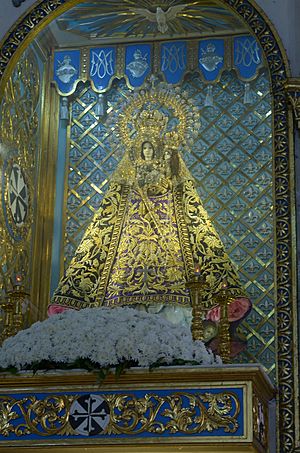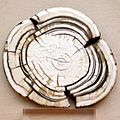Ivory facts for kids

Ivory is a hard, white material found in the tusks and teeth of certain animals. It has been used for art and making things for a very long time. Most famously, ivory comes from elephant tusks.
This special material is mostly made of dentine, which is a strong part of teeth and tusks. The basic structure of teeth and tusks is the same in all mammals, no matter the animal.
Many different animal teeth and tusks can be called "ivory." This is true if they are large enough to be carved and used for trade. People have valued ivory since ancient times. They used it to make many items, from detailed ivory carvings to false teeth, fans, dominoes, and special tubes.
While elephant ivory is the most well-known source, ivory also comes from mammoths (which are now extinct), walruses, hippopotamuses, sperm whales, killer whales, narwhals, and warthogs. Even elk have two small ivory teeth, which scientists believe are leftovers from their ancestors' tusks.
It is very important to know that buying or selling ivory from endangered animals, like African and Asian elephants, is against the law around the world. This helps protect these animals from harm.
What Was Ivory Used For?
Both the Greek and Roman civilizations used ivory a lot. They carved it to create many valuable artworks, important religious items, and fancy boxes for expensive things. Ivory was often used to make the white parts of eyes in statues. There is also some proof that ancient Irish people used ivory from whales or walruses.
The Chinese people have also valued ivory for a long time. They used it for both art and everyday items. Chinese artists carved ivory into many beautiful and useful objects. In Southeast Asia, Buddhist cultures traditionally collected ivory from their trained elephants. Ivory was prized for containers because it could create a very tight, airtight seal. It was also commonly carved into detailed seals. Officials used these seals to "sign" documents and laws by stamping them with their own unique design.
Sadly, the demand for ivory in the Classical world led to the extinction of elephant populations in Syria and North Africa.
Images for kids
-
A cylindrical ivory casket from Sicily and Arabia, found in the Hunt Museum.
-
A statue of the Blessed Virgin Mary and the Child Jesus made from elephant ivory.
-
An ivory tabernacle from France, showing the Madonna of Caress.
-
Men with elephant tusks in Dar es Salaam, around 1900.
-
An Ancient Greek ivory pyxis (a small box) showing griffins attacking stags. Late 15th century BC.
-
A carved ivory piece from the Pushkin Museum. It shows Christ blessing Emperor Constantine VII. Mid 10th century AD.
-
The ivory cover of the Codex Aureus of Lorsch, made around 810 by the Carolingian dynasty, now in the Victoria and Albert Museum.
-
A Madonna with Child statue from the Philippines, made in the 1600s.
-
Pig tusks.
-
A cross-section of a mammoth ivory tusk.
-
The Morgan Casket, an 11th-century ivory casket believed to be from Southern Italy. It is now in the Metropolitan Museum of Art.
-
A cubical ivory bead or game piece from the collections of the Hunt Museum.
-
Ivory workers in Calcutta, around 1903.
See also
 In Spanish: Marfil para niños
In Spanish: Marfil para niños

























